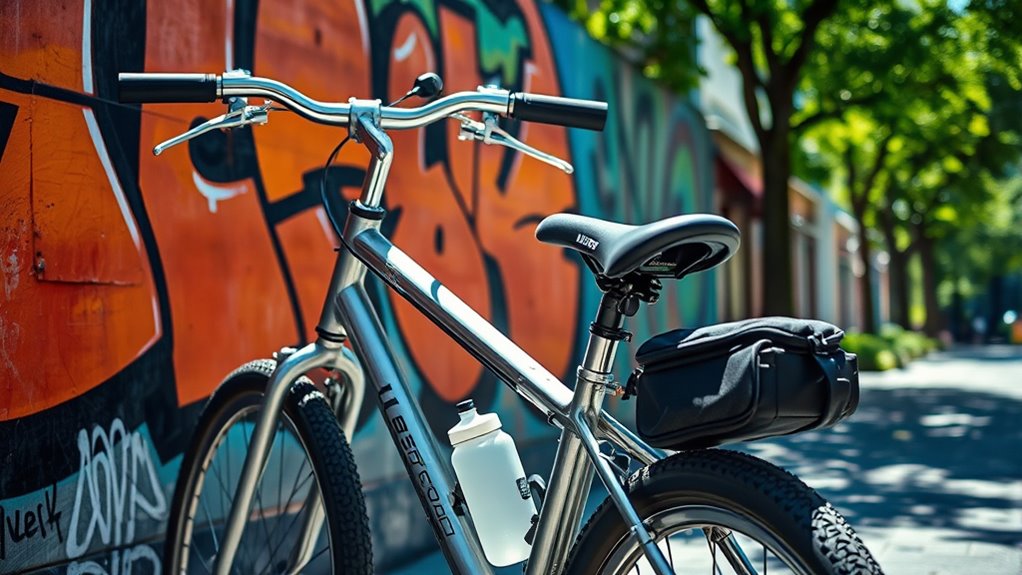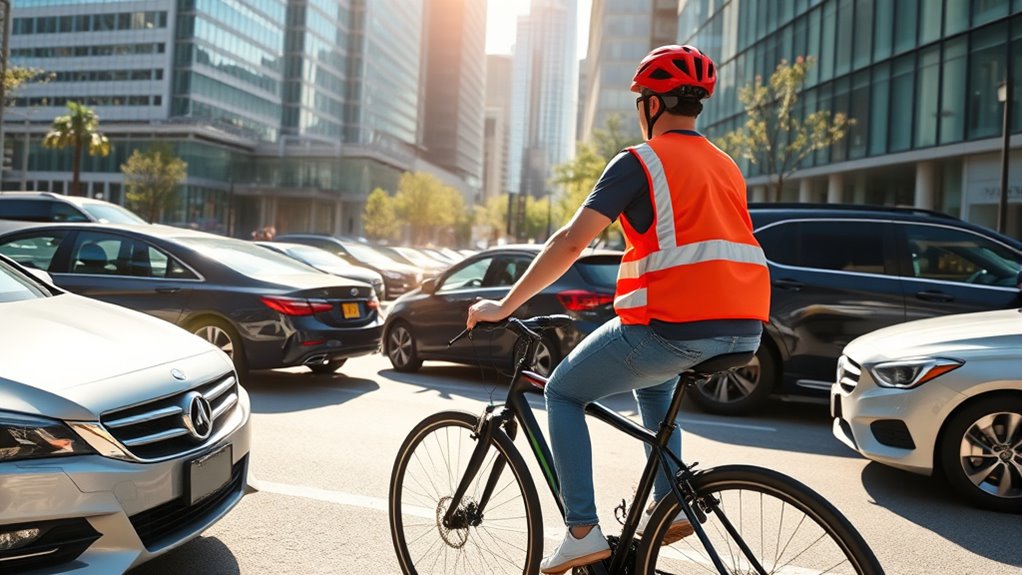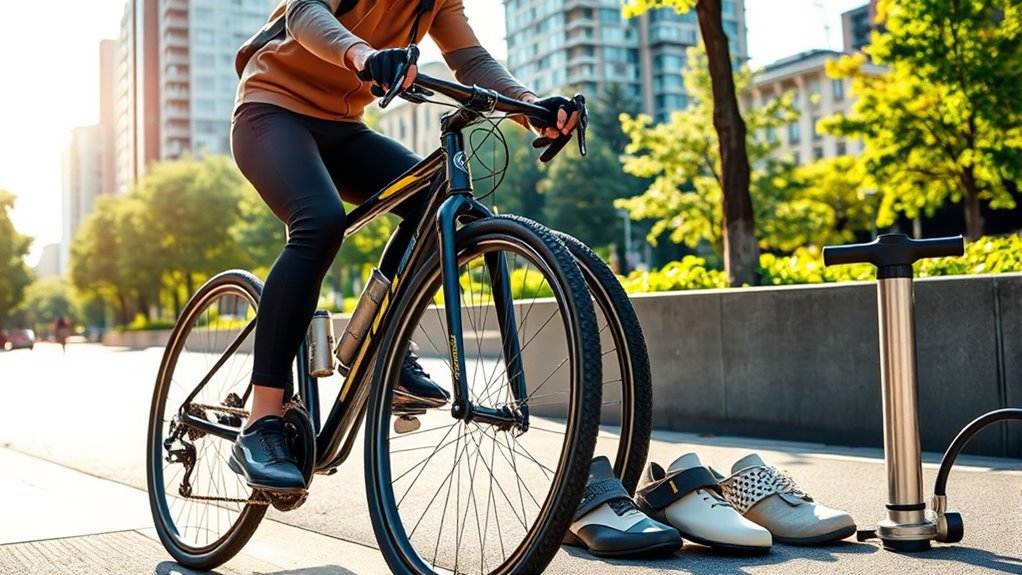Cycling saves you money by eliminating fuel, parking fees, and transit costs. Bikes have low maintenance needs, especially with high-quality components, which reduces repair expenses. City infrastructure supporting biking can cut congestion and transportation costs, while regular riding improves your health and lowers medical bills long term. Investing in durable gear and proper equipment maximizes savings and safety. To discover how biking benefits your wallet and community more, keep exploring these advantages.
Key Takeaways
- Cycling reduces transportation expenses by eliminating fuel, parking fees, tolls, and transit fares, leading to significant cost savings.
- Bikes have low maintenance and repair costs, especially with durable components and proper upkeep, extending their lifespan.
- Regular biking improves health, lowering medical expenses and reducing costs associated with chronic illnesses and doctor visits.
- Investment in quality gear and bike infrastructure offers long-term savings through durability, safety, and increased usage.
- Promoting cycling decreases urban congestion and reliance on cars, resulting in economic benefits such as time savings and reduced infrastructure strain.
Reducing Transportation Costs With Biking

Biking can considerably lower your transportation expenses compared to driving or using public transit. When you choose bike commuting, you avoid fuel costs, parking fees, and fare payments. Additionally, many cities now design bike-friendly infrastructure to support and encourage cycling, making it safer and more accessible for commuters. This shift reduces your reliance on expensive car ownership and public transit fares, saving you money each month. Plus, biking doesn’t require insurance or maintenance costs associated with vehicles, further decreasing your transportation expenses. Furthermore, the cost-effectiveness of cycling makes it an attractive option for budget-conscious individuals seeking reliable transportation. Engaging in cycling also promotes health benefits, which can reduce healthcare costs over time. Incorporating cycling into your routine can also enhance your overall urban mobility, making daily commutes more predictable and less stressful. The availability of smart bike-sharing systems in many urban areas further enhances the affordability and convenience of biking as a daily commute option.
Low Maintenance Expenses of Bicycles

You’ll find that bikes with durable components require fewer repairs and last longer, saving you money over time. Essential oils for maintenance can also help in keeping your bike components in good condition, reducing the need for costly repairs. Because maintenance needs are minimal, your expenses stay low and predictable. This is especially true for models with upgraded suspension systems, which are designed to withstand rougher terrains and reduce wear and tear. Additionally, selecting bikes with high-quality materials can further extend their lifespan and decrease repair frequency, making your cycling experience more economical. Choosing bikes made from robust materials can also provide added durability, thus minimizing replacement costs. This means you can enjoy cycling without worrying about frequent costly fixes.
Minimal Repair Costs
One of the key advantages of cycling is its low repair and maintenance costs. Unlike cars, bikes require minimal upkeep, saving you money over time. Regular checks on basic parts can prevent costly repairs. Additionally, the use of preventive maintenance can further reduce the likelihood of unexpected breakdowns and expenses. With bike sharing programs becoming more popular, you can access a bicycle without owning one, lowering your maintenance expenses even further. Good cycling infrastructure also supports easy repairs and quick fixes. For those interested in customizing or enhancing their bikes, Mazda Tuning principles—such as upgrading components and optimizing performance—can be loosely applied to bike maintenance to improve longevity and efficiency. Properly maintaining your bike with correct cleaning methods can help keep components in top condition and extend their lifespan. Being aware of smart features like app control and scheduling can help you plan maintenance and cleaning routines more effectively. To keep costs low, consider these tips:
- Keep tires properly inflated to avoid punctures.
- Lubricate the chain regularly to prevent rust.
- Tighten loose bolts to avoid damage.
- Use bike sharing programs for occasional riding without ownership costs.
These simple steps help you enjoy cycling with minimal repair costs.
Durable Bike Components
Durable bike components are essential for keeping maintenance costs low and ensuring your bike stays reliable over time. Investing in high-quality parts reduces the need for frequent repairs and aligns with sustainable manufacturing practices, minimizing environmental impact. Bike component innovation leads to longer-lasting, more efficient parts that withstand wear. By choosing durable components, you benefit from less downtime and lower expenses. Consider the following aspects:
| Component | Material/Innovation | Benefits |
|---|---|---|
| Drivetrain | High-strength alloys | Smooth shifting, longevity |
| Brakes | Carbon composites | Better durability, safety |
| Bearings | Sealed designs | Reduced maintenance |
| Frame | Lightweight, impact-resistant | Longevity, comfort |
Additionally, selecting components with advanced materials can further enhance durability and performance. Incorporating wear-resistant coatings into bike parts can also extend their lifespan and maintain optimal functionality. Using innovative manufacturing techniques can improve the overall quality and resilience of bike components, ultimately saving you money while supporting sustainable cycling.
Avoiding Fuel and Parking Fees

Have you ever considered how cycling can help you cut down on fuel and parking expenses? Bike commuting is a cost-effective, eco friendly transportation option that saves you money in multiple ways. Here are four key benefits:
Cycling saves money on fuel, parking, tolls, and maintenance—an eco-friendly way to commute.
- No fuel costs—cycling relies on your effort, not gas.
- Avoid parking fees, which can add up daily.
- Skip tolls and congestion charges often associated with car use.
- Reduce maintenance costs tied to fuel and engine wear.
Additionally, cycling requires minimal HVAC system maintenance, further reducing your overall expenses.
The Financial Benefits of Bike-Friendly Cities

Ever wonder how bike-friendly cities can save you money beyond just your commute? Well, smart urban planning and robust bike infrastructure play a big role. When cities prioritize bike lanes, secure parking, and accessible routes, you spend less on transportation costs.
These improvements encourage cycling, reducing reliance on cars and decreasing maintenance, fuel, and insurance expenses. Additionally, bike-friendly urban planning can lower your overall transportation budget by making biking safer and more convenient, which means fewer accidents and less need for costly repairs. Furthermore, investing in bike infrastructure can boost local economies by attracting tourism and encouraging small business growth. Implementing energy-efficient transportation options like biking aligns with sustainable practices and can contribute to a city’s energy consumption reduction. Moreover, promoting water-efficient transportation options like biking can help cities conserve water that might otherwise be used for vehicle maintenance and other related needs. Promoting integrated payment solutions for bike-sharing programs can also streamline rentals and attract more users. Developing tableware in public spaces can enhance the overall experience for cyclists and visitors alike.
Cities investing in cycling infrastructure also tend to have reduced traffic congestion, saving you time and money. Overall, a city that values biking not only supports healthier communities but also puts more dollars back in your pocket.
Health Savings and Reduced Medical Expenses

Choosing to bike regularly can lead to significant health savings by reducing your risk of chronic illnesses like heart disease, diabetes, and obesity. Proper bike ergonomics and comfortable cycling apparel help you stay injury-free and motivated.
When you ride consistently, you may experience:
- Lower healthcare costs due to fewer doctor visits
- Reduced medication needs for managing health conditions
- Improved cardiovascular health and stamina
- Fewer sick days and better overall productivity
Investing in ergonomic bikes and appropriate cycling apparel not only enhances comfort but also encourages longer, more frequent rides. As your fitness improves, your reliance on medical treatments diminishes, saving you money over time. Additionally, understanding the impact of infidelity on personal relationships highlights the importance of trust and emotional well-being, which can indirectly influence overall health and stress levels. Cycling becomes a cost-effective way to boost your health and cut medical expenses, especially when combined with proper training techniques that maximize safety and performance.
Long-Term Savings and Investment in Cycling Gear

Investing in quality cycling gear may require upfront costs, but it pays off in the long run by increasing durability and performance. High-quality equipment lasts longer, reducing the need for frequent replacements and saving you money over time.
As cycling infrastructure improves, biking becomes more accessible and safer, encouraging more sustained use. Bike sharing programs also support long-term savings by giving you access to bikes without the hefty investment, especially for occasional riders.
When you choose durable gear, you’re better prepared for diverse conditions, making cycling a reliable transportation option. Over time, these investments help you avoid costly medical bills from accidents and injuries, further enhancing your overall savings.
Long-term, your commitment to quality gear and supportive infrastructure maximizes your economic benefits.
Frequently Asked Questions
How Much Can I Realistically Save Annually by Biking Instead of Driving?
You can realistically save hundreds of dollars annually by biking instead of driving. You’ll cut costs on fuel, parking, and car maintenance, which adds up quickly.
While you’ll invest in cycling apparel and occasional bike maintenance, these expenses are usually lower than car costs.
Over time, your savings grow, making biking an economical choice that benefits your wallet and the environment.
Are There Tax Incentives or Rebates for Cycling Investments in Urban Areas?
When it comes to bike tax credits and cycling rebates, the waters can be murky, but many urban areas are catching on. You might qualify for incentives like bike tax credits or rebates for cycling investments, especially for e-bikes or bike infrastructure.
Check local government programs, as some cities offer incentives to promote eco-friendly commuting. Keep an eye out—you might find a financial lifeline that makes biking even more affordable.
How Does Cycling Impact Long-Term Healthcare Costs Beyond Immediate Savings?
Cycling can profoundly impact your long-term healthcare costs by reducing the risk of chronic disease. When you bike regularly, you improve cardiovascular health, strengthen muscles, and maintain a healthy weight, leading to substantial healthcare savings over time.
What Are the Environmental Economic Benefits of Increased Urban Cycling?
When you cycle more in urban areas, you help reduce urban congestion and air pollution. This decrease benefits the environment and lowers healthcare costs tied to pollution-related illnesses.
Your increased biking also promotes cleaner air, making cities healthier and more attractive.
How Can Cities Financially Support Cycling Infrastructure to Maximize Economic Benefits?
To support cycling infrastructure effectively, cities should leverage public-private partnerships, encouraging local businesses and organizations to invest in bike-friendly projects.
You can advocate for strategic funding allocation to prioritize bike lanes, parking, and safety measures.
By fostering collaboration and ensuring transparent budget use, you’ll help maximize economic benefits, reduce congestion costs, and promote healthier urban environments.
Making cycling a sustainable and financially smart transportation option for everyone.
Conclusion
By choosing to bike, you’re not just saving money—you’re opening a treasure trove of benefits that transform your life. Biking cuts costs, boosts health, and even helps the environment, making it a win-win. Imagine saving enough to buy a small island—your financial freedom grows with every pedal stroke. Embrace cycling today, and watch how it turns your everyday commute into a powerful, money-saving adventure that’s more valuable than gold.









